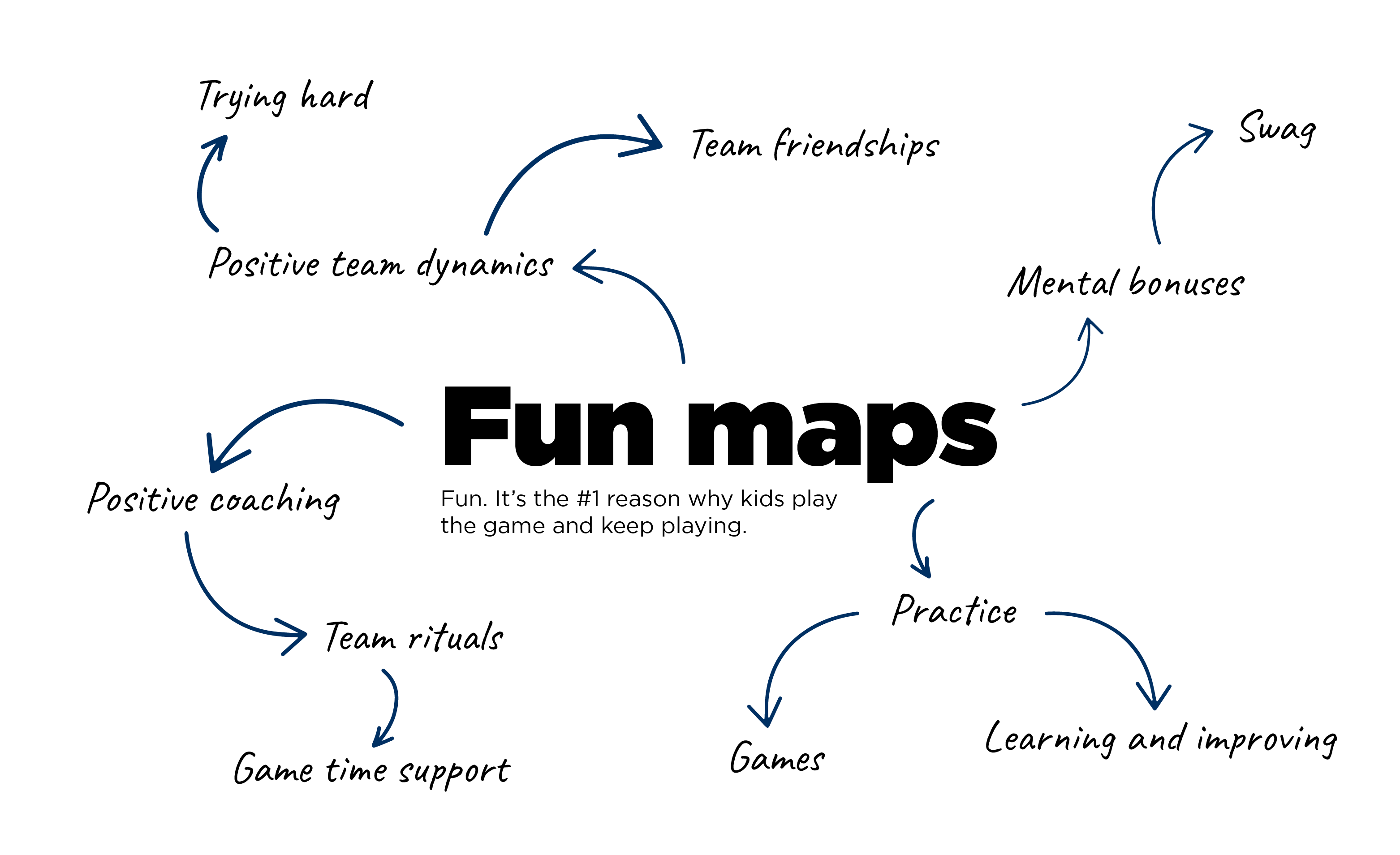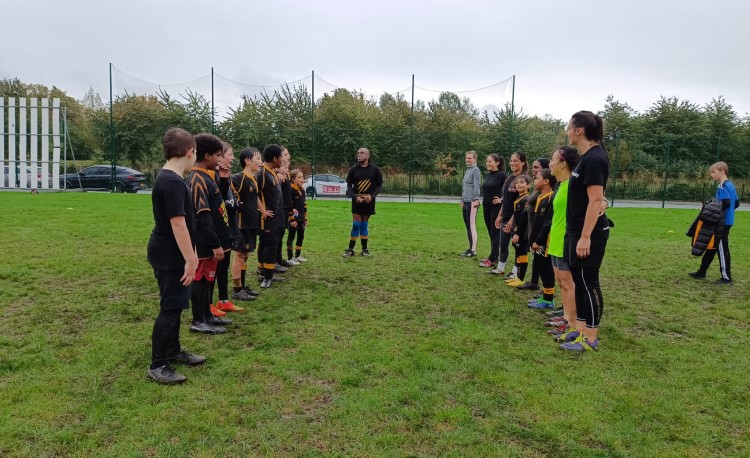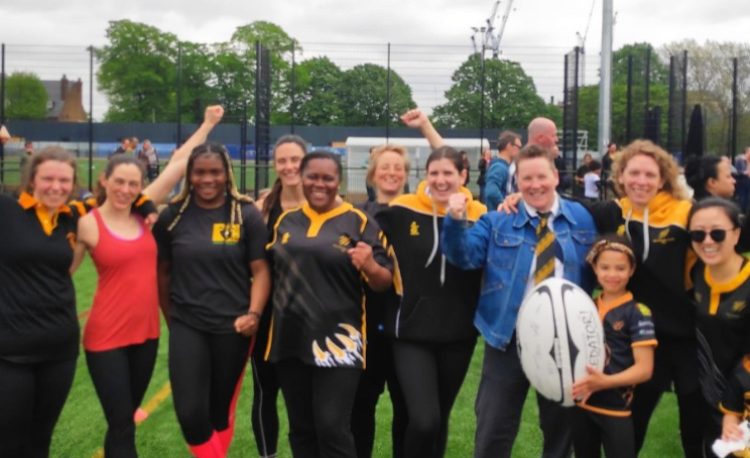Getting the right support
Breast health is important. Women and girls have reported feeling uncomfortable during exercise or put off altogether because of inadequate breast support. As well as hurting, breasts can be damaged if the fit of a bra isn’t right. Finding the right fit, especially for a sports bra, can feel like a minefield. Dr Nicola Brown, of St Mary’s University will help you feel supported for rugby.

Working for St Mary’s University, Nicola Brown conducted research into what makes a good fit of bra. Whether you’re an A or an E cup, 32 or 42 back size, don’t worry coaches, she’s also got advice for you on how to tackle this tricky issue at your club. Male or female, breast health education is empowerment.
TACKLE THE MISCONCEPTIONS
The key factor to sports bras and how effective they are is how well they fit.
Fit is a common problem among women. On average around 85% of women are thought to be wearing the wrong size bra.I did a study involving nearly 1300 marathon runners. They’re all doing high volumes of training. 97% said they were running in sports bras. However they generally rated their own knowledge of breast health as average or below average.
On average around 85% of women are thought to be wearing the wrong size bra
There’s still a lot of commonly held misconceptions around breasts. One is that the breast has muscle tissue in it which will support the breast and make them perkier.
However, the breast does not contain any muscle tissue. It’s support comes from the skin which can be damaged overtime from movement. There are thin, hair-like, structures inside the breast called Cooper’s ligaments. These are interwoven through the breast tissue and they provide the natural breast support.
If we don’t exercise with appropriate support we could be potentially damaging or stretching those supporting structures. That damage can sometimes be accompanied by pain, and we know a lot of women also experience breast pain.
Women can also experience pain in their breast that is related to their menstrual cycle. If players are experiencing pain, it might change their training patterns or they might want to reduce the intensity of the activity.
An athlete will be more comfortable saying there’s a pain in their hamstring or they’ve twisted their ankle compared with telling a coach they’re experiencing breast pain.
However, the pain might be impacting their performance. As women we tend to accept breast pain, but there’s a lot we can do to try and minimise it or eliminate it completely.
EDUCATION NEEDED
There has to be education about the importance of breast support, what different types of sports bras there are on the market and how you find the right one for you.
The fit of a bra is really important. It impacts health, quality of life, ability to exercise recreationally and athletic performance.
INJURY REPORT
In a survey of 297 female athletes from Australian Football, Rugby League, Rugby Union (15s and 7s) and 242 coaches and support staff, support staff estimated: 5% of players suffer from breast injuries, 58% athletes experienced a breast injury at training or a match.
Brooke Brisbine /University of Wollongong/Australian Institute of Sport
We did a study to look at how a good fitting sports bra can improve performance. If you change the level of breast support we identified that it changes your stride length when you’re running.
When you’re wearing little breast support you will tend to take shorter strides. It’s almost a protective mechanism; trying to absorb that movement and reduce the impact.
That is a reduction of one or two centimetres per step due to the change of strides. Over the course of a 5K, 10K or a marathon that would equate to quite a decrease in time if the runner was wearing a sport bra with a proper fit for them.
The statistic is a really good way to get across the importance of what a sports bra can do. Imagine if you cloned two runners and the only thing you changed was their breast support.
One was in a well fitted sports bra and one was not; the runner in the sports bra would finish a mile ahead of the other.
This corresponds to rugby as well, not just athletics. There’s running in rugby but also lots of contact. We want to keep people safe and secure so they can put themselves in the strongest position. Sports bras are an important part of this.
There was a study led by another breast research group in the University of Wollongong.
They looked at a range of different sports, including rugby and spoke to around 300 sportswomen and almost 250 coaching and medical staff. The survey reported that 58% of athletes said they had suffered a breast injury during training or a match. However, when asked the coaches and staff said they estimated only 5% had a breast injury.
I think it’s the first time that statistics around breast injuries in sport have been reported. Sport is good at tracking injuries but often the breast is ignored.
The stark difference between the athletes’ number of 58% and the coaches’ estimates of 5% is because we’re often not comfortable sharing information about our breasts.
ROLE MODELS CAN LEAD THE WAY
We need to create an environment where it can be easily talked about. One way to do this is to have an advocate within a group. It might be another player or an older player that is almost a role model.
Participants might feel more comfortable talking to them than they would do their coach. There’s an educational resource called Treasure Your Chest, which is aimed at young girls mainly but is a good start for anyone wanting to know more.
GIRLS AWARENESS
A study published 2016 found that
- 96% of girls (11-18) wear breast support
- 46% of girls said it affected their participation in exercise
- More than 50% said they had not worn a sports bra during sporting activities
Scurr, J., Brown, N., Smith, J., Brasher, A., Risius, D., & Marczyk, A. (2016). The influence of the breast on sport and exercise participation in schoolgirls in the UK. Journal of Adolescent Health. 58(2), 167-173.
We know that nearly half of girls say that they don’t want to participate in sport because of their breasts. They’re worried about pain, what they look like when they’re moving or what the boys think of them.
They also said they didn’t know anything about sports bras or how to check if they fit. There was a partnership set up by St Mary’s University, University of Portsmouth Research Group in Breast Health and University of Chichester Institute of Sport. Treasure Your Chest educational package came out of that partnership.
TREASURE YOUR CHEST
Treasure Your Chest is there to teach girls about their breast health. It’s free to use for schools and sports clubs.
Anyone can download it and use those resources. The starting point is making resources and information available.
Having a poster in the changing room would also plant seeds in their minds and they’ll want to know more.
Sometimes it’s also a case of sitting down and raising the topic. You can introduce the topic as an ice breaker and then try to encourage dialogue from the players.
It comes down to knowing the individuals. If players are looking to increase their performance, then they will be more interested in the marginal gains.
You can use that to get them engaged. However, having an advocate or a role model for players to talk to is one of the most important things. It’s really useful if you’re a male coach.
That’s not to say that male coaches shouldn’t talk about those issues. There are great male coaches that are happy to talk about ‘taboo’ subjects such as the menstrual cycle.
Just as there are female coaches that are uncomfortable and will avoid these topics. We need to educate coaches, irrespective of gender.
GET THE RIGHT FIT

A sports bra would be good to see on the list of recommended equipment for PE and it should be viewed the same as a mouth guard. It should be acknowledged this is equipment that is needed.
There’s different types of bras which can make it confusing when you’re looking for the right one. There’s the everyday style of bra that has two separate cups to hold each breast separately. That’s called the encapsulation bra. There’s the compression bra, which is more like a crop top bra.
Research shows that the compression bras are better suited to smaller breasted women. If you’re larger, an encapsulation sports bra is recommended for you.
There are also combination bras, which use elements from both styles. Those types of bras have a separate pocket for each breast and then a layer of compressive material over the top.
With compression bras, it’s important to think about the level of activity you’re doing. If you can stretch something over your shoulders, it’s not going to be that tight around your rib cage.
A common misconception is that the only support in a bra comes from the straps. Women aim to make the straps as tight as possible to try and lift the breasts.
However, it’s the underband that provides the majority of support. To get a good fit for the underband, it needs to be firm, to not ride up the back and it stays in place when you move.
In terms of research for the straps, there’s not a lot of difference between the two strap configurations for reducing breast movement. Whether you’ve got those vertical standard straps or the crossover racerback, there are generally the same kind of pressures on your shoulders.
However, it’s important to ensure that the shoulder straps aren’t slipping off your shoulders. Adjustable straps are good as you can change them to make them fit.
It’s important to talk about the fact that some women can get pressure sores, shoulder pain or neck pain from the straps, especially if they’re larger breasted.
Some women may add gel pads underneath their straps if they’re feeling a lot of pressure, but I’m not sure how effective that would be, especially with contact.
So it’s important to make sure the breasts are supported by the underband and not just the straps, so that the pressure is distributed over the whole bra.
When you think about most bras we focus on reducing the bounce, which is an up and down movement. However, the breast doesn’t just move up and down in a straight line. The breast moves in 3 directions. It moves up and down, side to side and forwards and backwards.
MULTIDIRECTIONAL SUPPORT
If you’re in a sport where you are changing direction, such as rugby, you should be looking for a bra that provides more mediolateral protection (side to side) as well.
This kind of sports bra might have additional stitching or extra cup support to limit the side to side movement.
There’s not really a lot of bras on the market that will say they’re designed with specific sports in mind. This is another reason why it’s so hard for women to find the right bra. It’s not just about knowing what size to have.
There’s no set or magic criteria for a bra to have in order to market itself as a sports bra.
My advice to try a bra on, jump around, move in it, so you can see how it feels for you. So don’t be afraid to jump around in the changing room, check if you can feel any movement. Look in the mirror and check again if you can see movement.
Go try on a bra, but go armed with information, so you know what to look for, for you.
You are your best advocate as to whether a product is working for you.
RIGHT FIT FOR RUGBY
Clothing for rugby must not have:
- Any sharp or abrasive item.
- Any items containing buckles, clips, rings, hinges, zippers, screws, bolts or rigid material or projection.
- Avoid sports bras with underwire and zippers.
Thank you for reading
to enjoy 3 free articles,
our weekly newsletter, and a free coaching e-book
Or if you are already a subscriber, login for full access
Newsletter Sign Up
Coaches Testimonials

Gerald Kearney, Downtown Las Vegas Soccer Club

Paul Butler, Florida, USA

Rick Shields, Springboro, USA

Tony Green, Pierrefonds Titans, Quebec, Canada
Subscribe Today
Be a more effective, more successful rugby coach
In a recent survey 89% of subscribers said Rugby Coach Weekly makes them more confident, 91% said Rugby Coach Weekly makes them a more effective coach and 93% said Rugby Coach Weekly makes them more inspired.
Get Weekly Inspiration
All the latest techniques and approaches
Rugby Coach Weekly offers proven and easy to use rugby drills, coaching sessions, practice plans, small-sided games, warm-ups, training tips and advice.
We've been at the cutting edge of rugby coaching since we launched in 2005, creating resources for the grassroots youth coach, following best practice from around the world and insights from the professional game.








